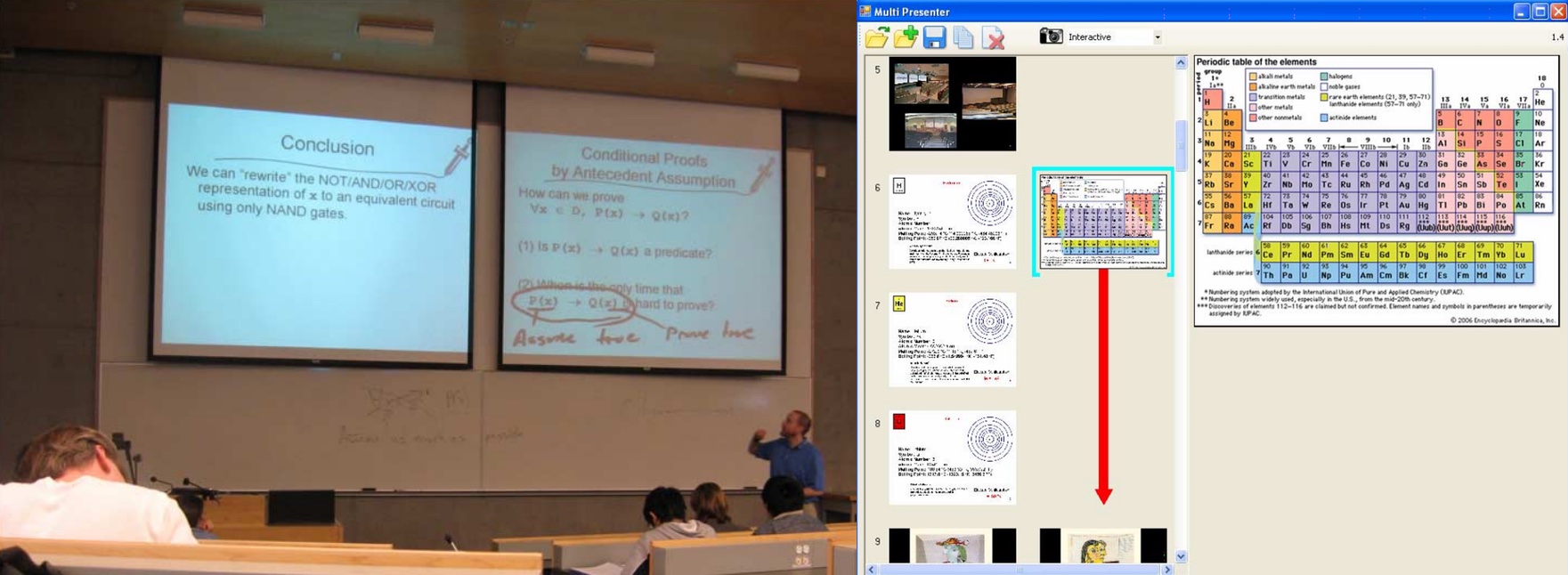Technologies for Teaching
Redefining learning through technology

In this series of works, we explore the role of large display and mobile technologies within the context of a university classroom. We explore how multiple displays can be used in ways that go beyond mirroring the display of the presenter (Lanir, Booth, & Tang, 2008), and how we can blur the lines between learners and instructors by challenging conventional notions of control across shared displays (Lanir, Booth, & Tang, 2010). These designs are built from careful studies of how people make use of large displays (Tang, Lanir, Greenberg, & Fels, 2009; Tang, Parker, Lanir, Booth, & Fels, 2006). A more recent design explored how sketching could be used as an input mechnism for a large display designed for teaching math (Grossauer, Perteneder, Haller, Walny, Brosz, Tang, & Carpendale, 2012) or for brainstorming (Peterender, Grossauer, Seifried, Walney, Brosz, Tang, Carpendale, & Haller, 2012).
Publications
Florian Peterender, Christian Grossauer, Thomas Seifried, Jagoda Walney, John Brosz, Anthony Tang, Sheelagh Carpendale, and Michael Haller. (2012). Idea Playground: When Brainstorming is Not Enough. In Designing Collaborative Interactive Spaces - Workshop at AVI 2012. (Jetter, Hans-Christian and Geyer, Florian and Reiterer, Harald and Dachselt, Raimund and Fischer, Gerhard and Groh, Rainer and Haller, Michael and Herrmann, Thomas, Eds.) (workshop).
Christian Grossauer, Florian Perteneder, Michael Haller, Jagoda Walny, John Brosz, Anthony Tang, and Sheelagh Carpendale. (2012). MathSketch: Designing a Dynamic Whiteboard for Instructional Contexts. In EIST 2012: Educational Interfaces, Software and Technology - Workshop at CHI 2012. (Tse, Edward and Marentette, Lynn V. and Ahmed, Syed Ishtianque and Thayler, Alex and Huber, Jochen and Mühlhäuser, Max and Kim, Si Jung "Jun" and Brown, Quincy, Eds.) (workshop).
Joel Lanir, Kellog S. Booth, and Anthony Tang. (2010). Enabling Student Control of a Classroom’s Shared Screen. In EIST 2010: Next Generation of HCI and Education: Workshop on UI Technology and Education Pedagogy - Workshop at CHI 2010. (Tse, Edward and Schöning, Johannes and Rogers, Yvonne and Shen, Chia and Morrison, Gerald, Eds.) (workshop).
Anthony Tang, Joel Lanir, Saul Greenberg, and Sidney Fels. (2009). Supporting transitions in work: informing large display application design by understanding whiteboard use. In GROUP ’09: Proceedings of the ACM 2009 international conference on Supporting group work, ACM, 149–158. (conference).
Joel Lanir, Kellogg S. Booth, and Anthony Tang. (2008). MultiPresenter: a presentation system for (very) large display surfaces. In MM ’08: Proceedings of the 16th ACM international conference on Multimedia, ACM, 519–528. (conference).
Anthony Tang, J Karen Parker, Joel Lanir, KS Booth, and Sidney Fels. (2006). Studying collaborative surface use to guide large display interaction design. In Conference Companion of the 2006 20th Anniversary Conference on Computer Supported Cooperative Work, 219–220. (poster).